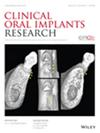氧化锆种植体支持双层单冠的长期性能:一项为期7.5年的双中心前瞻性队列研究结果。
IF 5.3
1区 医学
Q1 DENTISTRY, ORAL SURGERY & MEDICINE
引用次数: 0
摘要
目的评估后牙区氧化锆种植体支持的氧化锆单冠(SCs)在7.5年以上的生存率和成功率,以及患者报告的结果。材料与方法45例患者接受了由氧化锆框架与白晶石增强长石陶瓷层合而成的氧化锆支撑的后路sc (n = 45)。7.5岁时,评估临床参数和技术并发症。技术成功与否是根据修改后的美国公共卫生局(USPHS)标准确定的。采用视觉模拟量表(VAS)评估患者报告的预后指标(PROs)。Wilcoxon配对对符号秩检验、混合效应有序逻辑回归和线性混合模型分析了随时间变化的效应。结果随访7.5年(平均:92.1±3.4个月),共获得30例SCs。SCs的Kaplan-Meier存活率为97.5% [95% CI: 83.6%-99.6%]。由于主要切屑(n = 3)、咬合粗糙(n = 7)、边缘缝隙(n = 1)和过度轮廓(n = 2)的重建,成功率下降到79.4%[63.0%-89.2%]。从治疗前到分娩,PROs表现出显著的改善(VAS评分:93%-97%),并在整个随访期间保持稳定。结论氧化锆种植体支持的氧化锆贴面干细胞具有较高的存活率,并始终满足患者的功能和美学期望。尽管这些良好的结果,相当大的技术并发症的发生率值得通过长期的临床研究进一步调查。临床意义虽然贴面氧化锆冠具有良好的美观性,但其后牙区易碎裂,提示整体替代可能更可取。需要进一步的研究来优化材料选择和减少技术复杂性。本文章由计算机程序翻译,如有差异,请以英文原文为准。
Long-Term Performance of Bi-Layered Single Crowns Supported by Zirconia Implants: 7.5-Year Results of a Two-Center Prospective Cohort Study.
OBJECTIVE
To evaluate the survival and success rates of veneered zirconia-based single crowns (SCs) supported by zirconia implants in posterior regions, along with patient-reported outcomes, over 7.5 years.
MATERIALS AND METHODS
Forty-five patients received zirconia implant-supported posterior SCs (n = 45) composed of zirconia frameworks layered with a leucite-reinforced feldspathic ceramic. At 7.5 years, clinical parameters and technical complications were assessed. Technical success was determined according to modified United States Public Health Service (USPHS) criteria. Patient-reported outcome measures (PROs) were evaluated using visual analog scales (VAS). Wilcoxon matched-pairs signed-rank test, mixed-effects ordered logistic regression, and linear mixed models analyzed time-dependent effects.
RESULTS
Thirty SCs (n = 30) could be evaluated at the 7.5-year follow-up (mean: 92.1 ± 3.4 months). Kaplan-Meier survival for SCs was 97.5% [95% CI: 83.6%-99.6%]. Success dropped to 79.4% [63.0%-89.2%] due to reconstructions with major chipping (n = 3), occlusal roughness (n = 7), marginal crevice (n = 1), and over-contouring (n = 2). PROs showed significant improvements from pre-treatment to delivery (VAS scores: 93%-97%) and remained stable throughout the follow-up period.
CONCLUSION
Veneered zirconia-based SCs supported by zirconia implants in posterior sites demonstrated high survival rates and consistently met patients' functional and esthetic expectations. Despite these favorable outcomes, the considerable incidence of technical complications warrants further investigation through long-term clinical studies.
CLINICAL SIGNIFICANCE
While veneered zirconia crowns offer favorable esthetics, their susceptibility to chipping in posterior regions suggests that monolithic alternatives may be preferable. Further research is needed to optimize material selection and minimize technical complications.
求助全文
通过发布文献求助,成功后即可免费获取论文全文。
去求助
来源期刊

Clinical Oral Implants Research
医学-工程:生物医学
CiteScore
7.70
自引率
11.60%
发文量
149
审稿时长
3 months
期刊介绍:
Clinical Oral Implants Research conveys scientific progress in the field of implant dentistry and its related areas to clinicians, teachers and researchers concerned with the application of this information for the benefit of patients in need of oral implants. The journal addresses itself to clinicians, general practitioners, periodontists, oral and maxillofacial surgeons and prosthodontists, as well as to teachers, academicians and scholars involved in the education of professionals and in the scientific promotion of the field of implant dentistry.
 求助内容:
求助内容: 应助结果提醒方式:
应助结果提醒方式:


